Jewellery - Lehrsammlung - Published objects
Published objects
Several works of art and artefacts that are or have been in our online gallery are published in literature. We often receive requests concerning published objects when more research or other publications on them are planned. Therefore we will give a list of published objects without this list being claimed to be exhaustive. If you are researching artefacts that have once been handled by our gallery or you would like to investigate an object still in our possession please do not hesitate to contact us. We will be glad to help.
-
 Vollständiger römischer Ritualspiegel
Vollständiger römischer RitualspiegelSpiegel aus Blei und Glas mit ornamentalem Dekor. Vollständige Ritualspiegel sind eine außerordentliche Seltenheit. 51,0 Gramm schwer. Aus dem 3. bis 4. Jh. n. Chr.
Price: on request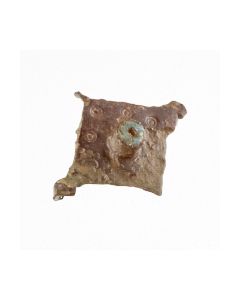 Roman fibula from the Richard Hattatt collection
Roman fibula from the Richard Hattatt collectionLozenge-shaped ancient roman fibula. The piece is published in the standard work "Iron Age and Roman Brooches". Found in Britain.
Price: on request Published Roman fibula with celtic design
Published Roman fibula with celtic designAncient fibula from the Roman province of Britain. The design can be attributed to the celtic tribe of the Trinovantes or Iceni. From the famous Hattatt collection. Published twice.
Price: on request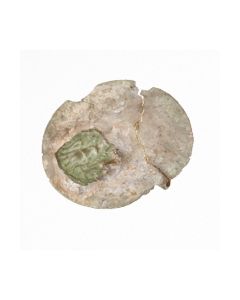 Ancient fibula from the Hattatt collection
Ancient fibula from the Hattatt collectionAncient fibula of the rare adlocutio type. Repoussé work of a scene from a Roman sestertius of Hadrian in celtic style. Find from Dorset in Roman Britain. Published in Hattatts famous book series on ancient fibulae.
Price: on request Rare plate brooch with millefiori enamel
Rare plate brooch with millefiori enamelBrooch from Roman Imperial time, found in Roman Britain. It is an extremely rare and interesting type. The brooch is published in Richard Hattatt's standard work "Ancient Brooches and Other Artefacts" and discussed in detail.
Price: on request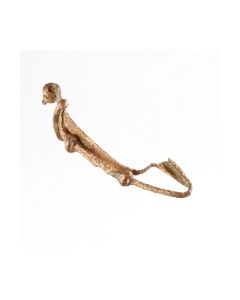 Celtic fibula from the famous Hattatt collection
Celtic fibula from the famous Hattatt collectionFibula from the La Tène II period. Found in Celtic Carnuntum. The piece is published in the standard work "Iron Age and Roman Brooches".
Price: on request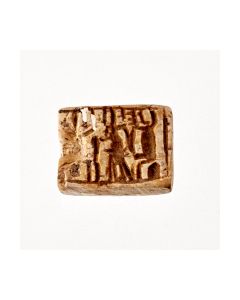 Egyptian steatite plaque
Egyptian steatite plaqueThe protective amulet shows the god Bes between two seated monkeys. Late Period of ancient Egypt. This piece is described in the catalogue of Irène Gautier-Vodoz.
Price: on request Roman fibula from the Richard Hattatt collection
Roman fibula from the Richard Hattatt collectionLozenge-shaped ancient roman fibula. The piece is published in the standard work "Iron Age and Roman Brooches". Found in Norfolk, England.
Price: on request Published bracelet with Luristan ram heads
Published bracelet with Luristan ram headsNicely worked zoomorphic terminals with close parallels to achaemenide art. Dating to the early 1st Millenium BC.
Price: on request Melon bracelet from the Hallstatt period
Melon bracelet from the Hallstatt periodThe massive bronze bracelet was found in Mintraching, Germany. The piece is published in an archeological report. Around 600 BC.
Price: on request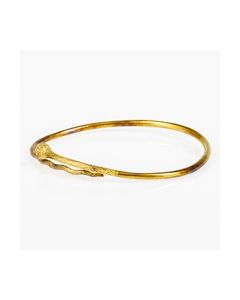 Golden circlet in the shape of a snake
Golden circlet in the shape of a snakeBeautiful piece of gold jewellery from Egypt in Roman Imperial times. Published in the exhibition catalogue of the Basel Museum of Ancient Art.
Price: on request Golden fingerring in the shape of a snake
Golden fingerring in the shape of a snakeBeautiful gold ring from Egypt in Roman Imperial times. Published in the exhibition catalogue of the Basel Museum of Ancient Art.
Price: on request Golden fingerring in the shape of a snake
Golden fingerring in the shape of a snakeBeautiful gold ring from Egypt in Roman Imperial times. Published in the exhibition catalogue of the Basel Museum of Ancient Art.
Price: on request Roman bracelet with hunting scene
Roman bracelet with hunting sceneThis rare and elaborate silver repoussé is analyzed in a 1970 publication and attributed to a workshop in Antioch or Palmyra. Late 3rd century AD.
Price: on request Egyptian hippopotamus amulet
Egyptian hippopotamus amuletMade in the style of a scarab but with a hippopotamus on the upper side. It was a protective amulet during the 18th or 19th dynasty of Ancient Egypt. It might have protected a pregnant woman. The amulet comes from the famous Matouk collection and is published in his 1971 book.
Price: on request Villanovan fibula from the Hattatt collection
Villanovan fibula from the Hattatt collectionBronze brooch of the Italic Iron Age. The piece is published in the standard work "Brooches of Antiquity".
Price: on request Villanovan fibula from the Hattatt collection
Villanovan fibula from the Hattatt collectionSerpentine bronze brooch of the Italic Iron Age. The piece is published in the standard work "Brooches of Antiquity".
Price: on request Hellenistic gold diadem
Hellenistic gold diademMagnificent head-dress in the shape of a pediment from the time of Alexander the Great. Embossed with a floral decoration, supplemented by birds and grasshoppers. This piece has been published in a 1965 standard work on hellenistic gold jewellery.
€6,380 Large Villanovan fibula from the Hattatt collection
Large Villanovan fibula from the Hattatt collectionImposing bronze brooch of the Italic Iron Age. The piece is published in the standard work "Brooches of Antiquity".
Price: on request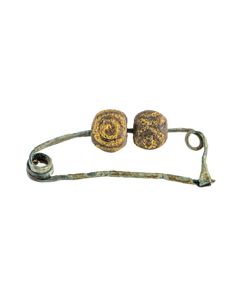 Early Italic brooch decorated with beads
Early Italic brooch decorated with beadsThere rare brooch type from northern Italy is based on predecessors from Greece. The piece is from the famous Richard Hattatt collection and is published in two of his works.
Price: on request Phrygian fibula from the Hattatt collection
Phrygian fibula from the Hattatt collectionBronze fibula from Anatolia around the time of King Midas. The piece is published in two standard works and was on loan to the Ashmolean Museum.
Price: on request Predynastic hippopotamus amulet
Predynastic hippopotamus amuletWonderful figurine made of orange-red carnelian. Dating to the birth of Ancient Egypt. The rare piece was already scientifically studied in 1913.
Price: on request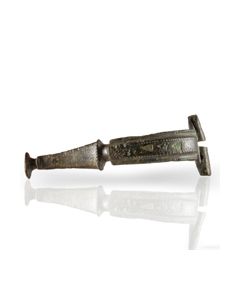 Roman Hod Hill brooch from the Hattatt collection
Roman Hod Hill brooch from the Hattatt collectionNice and rare enameled variant of the Hod Hill type. Found in Norfolk, UK. The piece is published in two books by Richard Hattatt.
Price: on request Celtic penannular brooch
Celtic penannular broochPossibly made by the Celtic Durotriges tribe under Roman rule in Britain. The piece is published in two books by Richard Hattatt.
Price: on request Brooch from Roman Britain
Brooch from Roman BritainThis rare variant of the T-shaped brooches was found in Lechlade, Gloucestershire. It dates to the 1st or 2nd century AR. From the famous Hattatt collection and published in two standard works for ancient fibulae.
Price: on request Dolphin brooch from Roman Britain
Dolphin brooch from Roman BritainThe so-called dolphin brooch is very British. This specimen was probably made by the Celtic Corieltauvi tribe, shortly after the arrival of the Romans in the middle of the 1st century. Published in two works by Richard Hattatt.
Price: on request Celtic brooch from Iberia
Celtic brooch from IberiaThe early Celtic brooch dates from the 6th century BC and was found in Spain. This specimen is published in two standard works on ancient brooches.
Price: on request Flying bird brooch from Roman Britain
Flying bird brooch from Roman BritainA local British production from the 2nd century. It is taking up a continental brooch type. From the famous Hattatt collection and published in two standard works on ancient brooches.
Price: on request Roman rosette brooch from Colchester
Roman rosette brooch from ColchesterA nice brooch type from the 1st century with an especially well preserved decorative disc. From the famous Hattatt collection and published in two standard works on ancient brooches.
Price: on request Disc brooch from Roman Britain
Disc brooch from Roman BritainNicely enameled brooch with a Romano-Celtic sunburst design. From the 2nd century AD. Published in two stardard works on ancient brooches by Richard Hattatt.
Price: on request Trumpet brooch with Celtic decorations
Trumpet brooch with Celtic decorationsUnusual and rare variant of high importance, published several times. Beautiful silver inlays on the bow showing tendrils in Celtic style. From the 1st century.
Price: on request Roman Kraeftig Profilierte fibula
Roman Kraeftig Profilierte fibulaFibula with noble green patina. An import from mainland Europe to Roman Britain. From the 1st century AD. Published in two stardard works on ancient brooches by Richard Hattatt.
Price: on request Roman plate brooch
Roman plate broochOval bronze brooch with a setting for a glass insert. From the Roman imperial period. Published in two stardard works on ancient brooches by Richard Hattatt.
Price: on request Roman crossbow brooch
Roman crossbow broochVery nice specimen with niello inlays and remains of the original gilding. From the mid 4th century AD. Published in two stardard works on ancient fibulae.
Price: on request Etruscan scarab with athletes
Etruscan scarab with athletesMiniature work of art of the highest quality, a flagship of late Etruscan glyptics. Made of shimmering orange carnelian. Published several times and with provenance dating back to the 19th century.
Price: on request Roman headstud brooch
Roman headstud broochInteresting fibula with a covered hinge mechanism and enamel decoration on the bow. From the 2nd century Roman Britain. Published in two stardard works on ancient brooches by Richard Hattatt.
Price: on request

